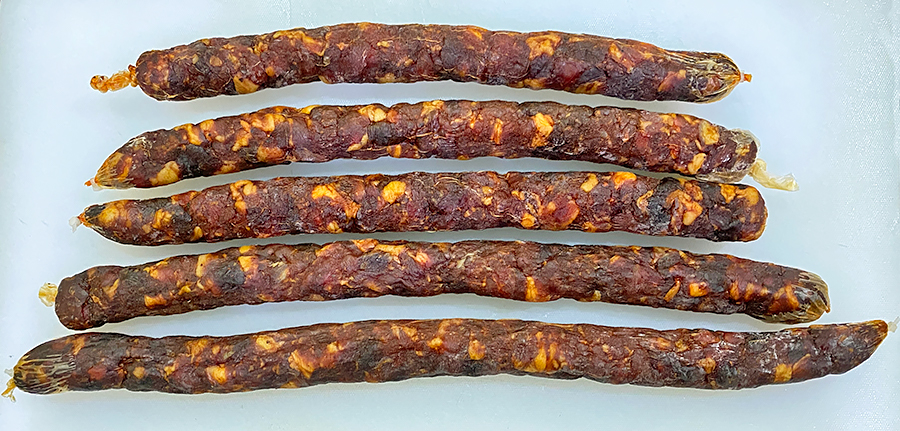|
Clem's Pepperoni |
|
Pepperoni
is an American salami. The latter is a fermented (cured) and
air-dried thick sausage comprising pork and beef, spiced with
paprika, chilli amongst others. It is a favourite topping on
pizzas. The pepper in the name refers to spicy capsicums
rather than peppercorns.
Here are the ingredients I used
to make a batch:

The amounts are
for 4.5 kilograms of meat
-
Paprika
3 tablespoons
-
Peppercorn
1 tablespoon or much more to taste
-
Fennel powder
1 tablespoon
-
Chilli powder
2 tablespoons or more to taste
-
Sugar
1 tablespoon
-
Salt
5 tablespoons
-
Garlic
1 clove; minced
-
Ascorbic acid
1/2 teaspoon
-
Pink Curing
Salt 2 teaspoons (also known as Prague
Powder or Instacure #1)
-
Beef; finely
diced (25% of total meat weight)
-
Fatty pork
e.g. belly finely diced; (75% of total meat weight)
-
Salami casing
(dried)
-
OPTIONAL: I
added 4 capsules of Lactobacillus fermentum (to 1.5
kg of meats) in place of any starter culture on the basis
that the latter is a Lactobacillus like salami
starter cultures available on the market. The L.
fermentum came from a bottle of probiotics. Starter
cultures do two things in the curing: lower the pH, and add
flavors.
-
OPTIONAL:
Since my pepperoni will not be hung and smoked, I chose to
add a few drops of liquid smoke (Wright's Hickory Liquid
Smoke) for extra flavor.
|
|
Production
notes:
-
Important: I
made this batch not to be eaten raw even after curing. This
is because of the potential for raw pork to harbor parasites
(worms of various descriptions). I intend to use this
pepperoni as pizza topping in which case, they will be
cooked when the pizza is baked.
-
Important:
When preparing raw meat products even if cured by
fermentation, there is a risk of the proliferation of
pathogenic microorganisms. Traditional production includes
the assistance of "good" microbes (bacteria and fungi) which
cure the meat by lowering the pH of the sausage to
sufficiently low levels such as to deter the growth of
pathogens; and the fungi serve to add flavor (as with
cheeses). Thus, in my case, I chose to be cautious by adding
the Pink Curing Salt which contains Sodium Nitrate. The
latter supplies nitrites which act as a bacteriostatic agent
(I realize that this may make my addition of L. fermentum
redundant but it never hurts to try). Further, nitrites
helps preserve the red color of meats (reaction with
myoglobin). The use of nitrates is controversial because it
is thought that nitrites in foods can be converted to
cancer-inducing compounds in the gut. However, to use or not
to use is a consideration which takes care of the risk of
food poisoning by pathogenic microbes. The FDA recommends
the use of less than 0.2 g of Sodium Nitrate per kilogram of
food (FDA 172.175).
-
IMPORTANT: To
replicate a drop in pH of the meat during curing, I added
the ascorbic acid (Vitamin C). This lowers the pH of the
meat without a salami starter culture (remember that I added
the L. fermentum just for extra coverage). Do not
make cured meats such as salami or pepperoni if you cannot
assure a low pH in the meats which are curing. You could be
making a batch of stomach (or worse) trouble instead.
|
|
Here is the batch
freshly made:

The width of the tray in view is 45 cm.
The cased meats will be kept in my refrigerator for some 4 - 6 weeks
to cure and dehydrate (the aim is to lose about 40% its weight
through water evaporation). A refrigerator should have a
sufficiently dry atmosphere for drawing out the water in the
meats but the temperature would be lower than is usual for
curing. Thus, the results of this production will only be known
some 6 weeks hence.
|

The cased meats
after four weeks of curing in the refrigerator.
The dried weight was 1 kg which meant that 45% of the original
weight was lost through drying.
|
|

Sliced.
As they say:
"Just like a bought one!"
Verdict:
Tasty, flavoursome and much like the ones I buy from a
deli in Sydney. If anything, I would add more coarse ground
pepper and stop the drying/earlier so that the pepperoni is more
moist (losing just 30% of fresh weight might be the way to go
for this recipe).

Used as topping in a pizza with ham, chicken and mushroom
|
20 May 2021/21
June 2021
Created by Clem Kuek
|




